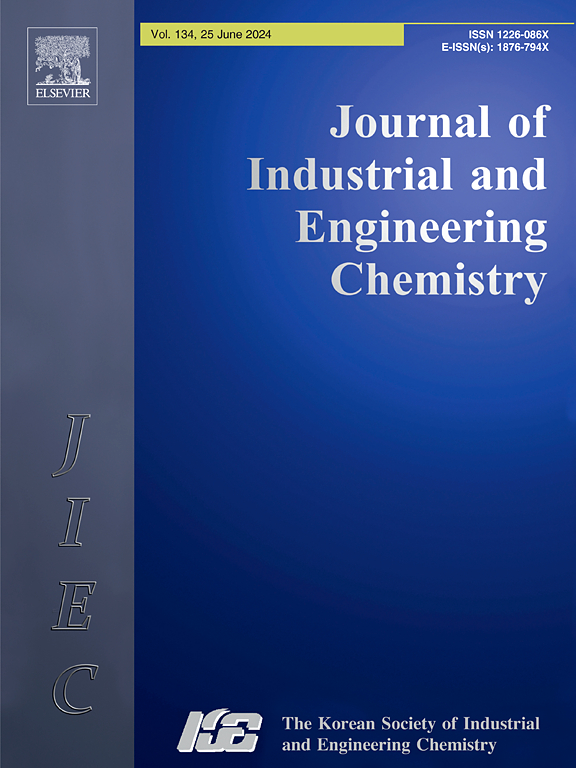Influence of benzothiophene based acceptors modulation on photovoltaic properties of Trimethyl-2-selena-5-aza-pentalene-4,6-dione based chromophores through quantum chemical investigations
IF 5.9
3区 工程技术
Q1 CHEMISTRY, MULTIDISCIPLINARY
Journal of Industrial and Engineering Chemistry
Pub Date : 2025-02-23
DOI:10.1016/j.jiec.2025.02.046
引用次数: 0
Abstract
Non-fullerene organic compounds are widely utilized to enhance the efficiency of photovoltaic materials. Herein, we designed a series of novel selenophene based compounds (DSBD1-DSBD8) with A1–π–A2–π–A1 architecture from DSBDR, which was derived from recently synthesized TPD-T-CN compound. The structural design process involved replacing the thiophene rings with selenophene units, which possess a higher degree of polarization, and altering the various terminal acceptor units of TPD-T-CN. Various analyses such as absorption properties (UV–Vis), open circuit voltage (Voc), density of states (DOS) were executed at CAMB3LYP/6-311G(d,p) functional, to analyze the optical and photovoltaic parameters of designed compounds. All the designed molecules (DSBD1-DSBD8) were observed with suitable band gaps (ΔE = 2.690–2.542 eV) with larger bathochromic shifts (λmax = 610.098–642.505 nm in dichloromethane) than DSBDR. The lower binding energy values (Eb = 0.658–0.612 eV) indicated easy charge transport between molecular orbitals with the higher exciton. Further, Voc analysis was conducted with respect to HOMOPBDBT-LUMOACCEPTOR and all of the derivatives exhibited a comparable voltage value with that of the reference chromophore. Therefore, it can be inferred that through molecular engineering with efficient acceptor moieties and integrating selenophene rings, the efficiency of NF-based photovoltaic materials could be improved.
基于苯并噻吩的受体调制对基于三甲基-2-硒-5-氮杂-戊烯-4,6-二酮的发色团光电性质的影响
非富勒烯类有机化合物被广泛用于提高光伏材料的效率。本文以最近合成的TPD-T-CN化合物DSBDR为原料,设计了一系列具有A1 -π-A2 -π-A1结构的新型硒烯基化合物DSBD1-DSBD8。结构设计过程包括将噻吩环替换为具有更高极化度的硒代噻吩单元,并改变TPD-T-CN的各种末端受体单元。在CAMB3LYP/6-311G(d,p)官能团上进行了吸收特性(UV-Vis)、开路电压(Voc)、态密度(DOS)等分析,分析了所设计化合物的光学和光伏参数。所有设计的分子(DSBD1-DSBD8)均具有合适的带隙(ΔE = 2.690-2.542 eV)和较大的色移(在二氯甲烷中λmax = 610.098-642.505 nm)。较低的结合能值(Eb = 0.658 ~ 0.612 eV)表明具有较高激子的分子轨道间容易发生电荷输运。此外,对HOMOPBDBT-LUMOACCEPTOR进行了Voc分析,所有衍生物都显示出与参考发色团相当的电压值。因此,可以推断,通过高效受体基团的分子工程和集成硒烯环,可以提高nf基光伏材料的效率。
本文章由计算机程序翻译,如有差异,请以英文原文为准。
求助全文
约1分钟内获得全文
求助全文
来源期刊
CiteScore
10.40
自引率
6.60%
发文量
639
审稿时长
29 days
期刊介绍:
Journal of Industrial and Engineering Chemistry is published monthly in English by the Korean Society of Industrial and Engineering Chemistry. JIEC brings together multidisciplinary interests in one journal and is to disseminate information on all aspects of research and development in industrial and engineering chemistry. Contributions in the form of research articles, short communications, notes and reviews are considered for publication. The editors welcome original contributions that have not been and are not to be published elsewhere. Instruction to authors and a manuscript submissions form are printed at the end of each issue. Bulk reprints of individual articles can be ordered. This publication is partially supported by Korea Research Foundation and the Korean Federation of Science and Technology Societies.

 求助内容:
求助内容: 应助结果提醒方式:
应助结果提醒方式:


